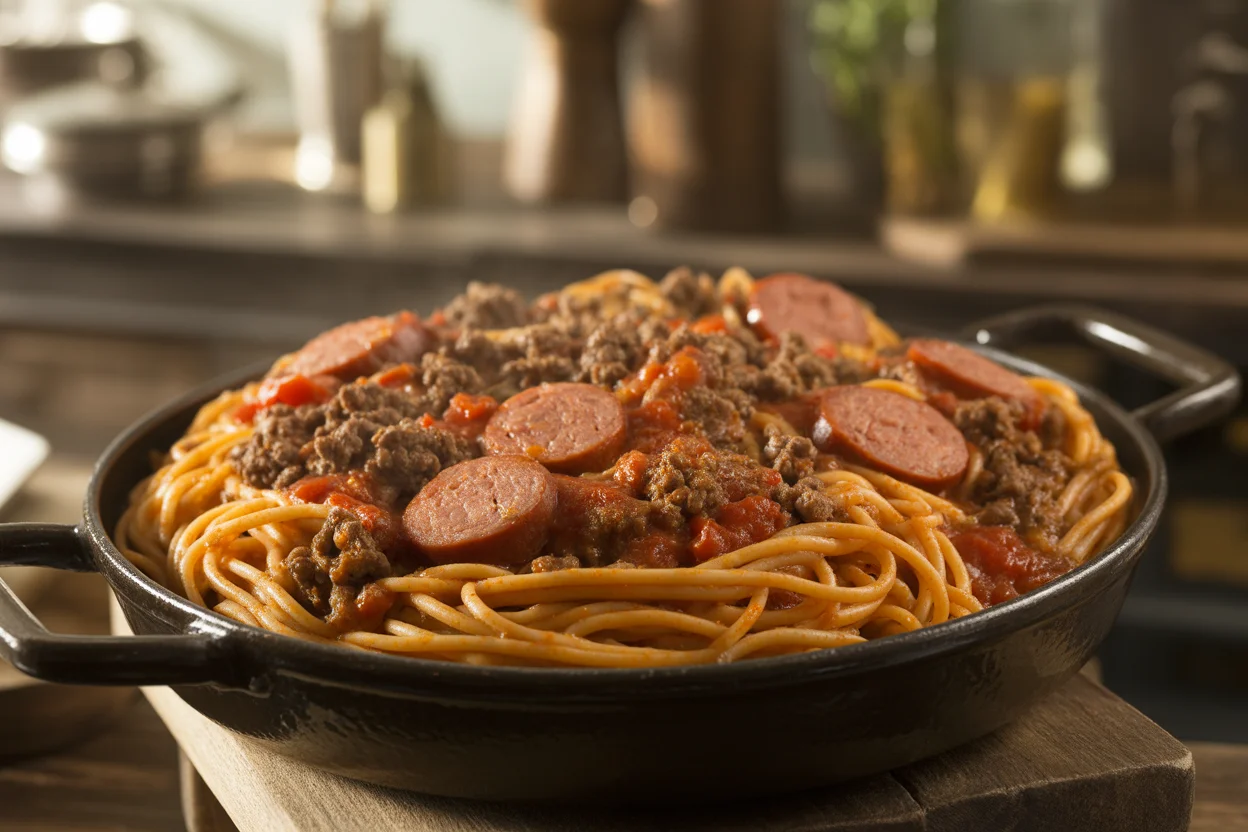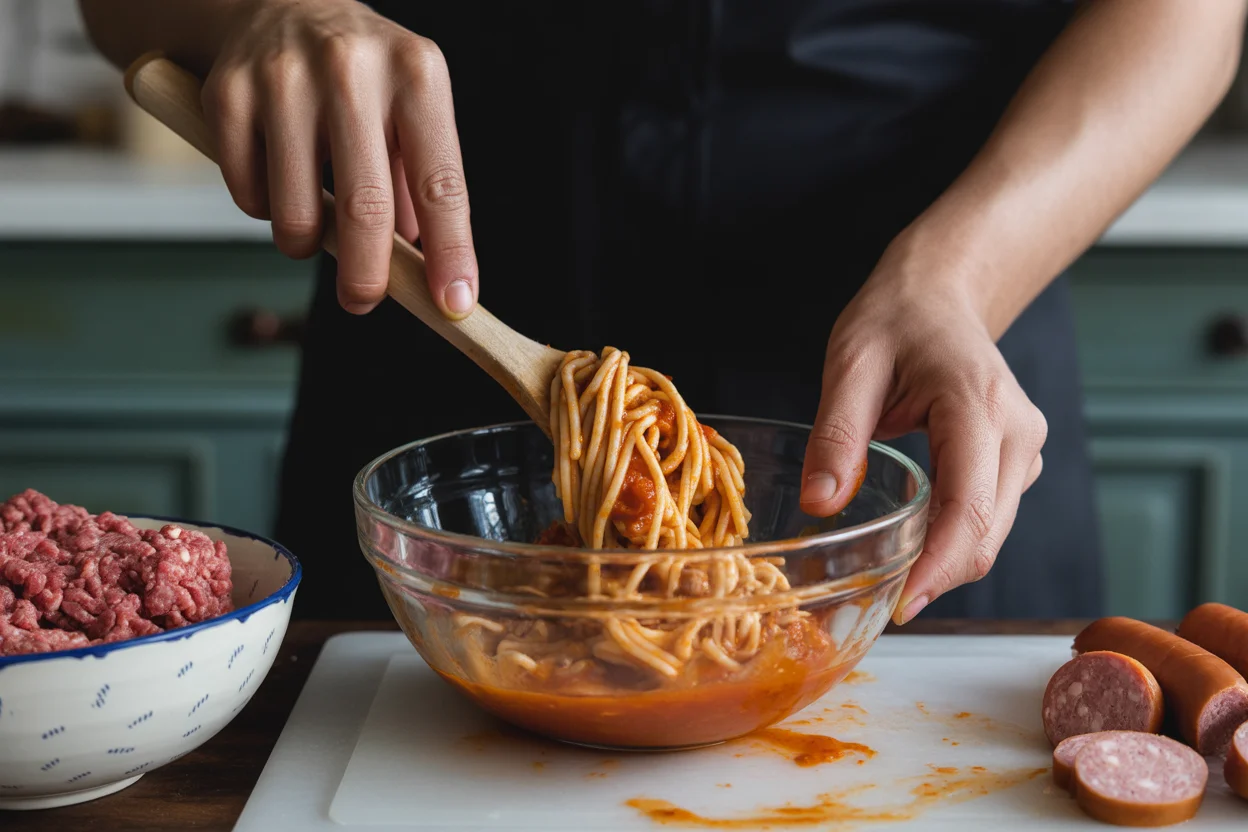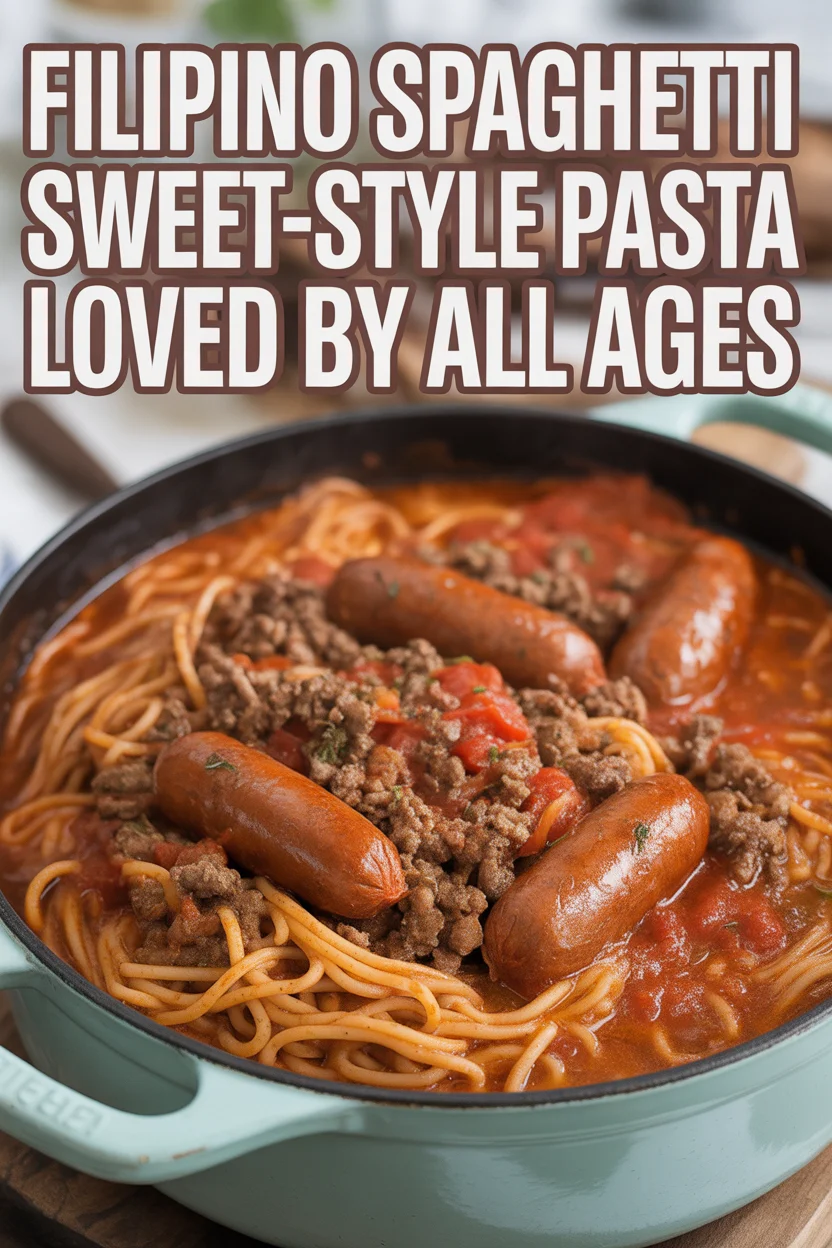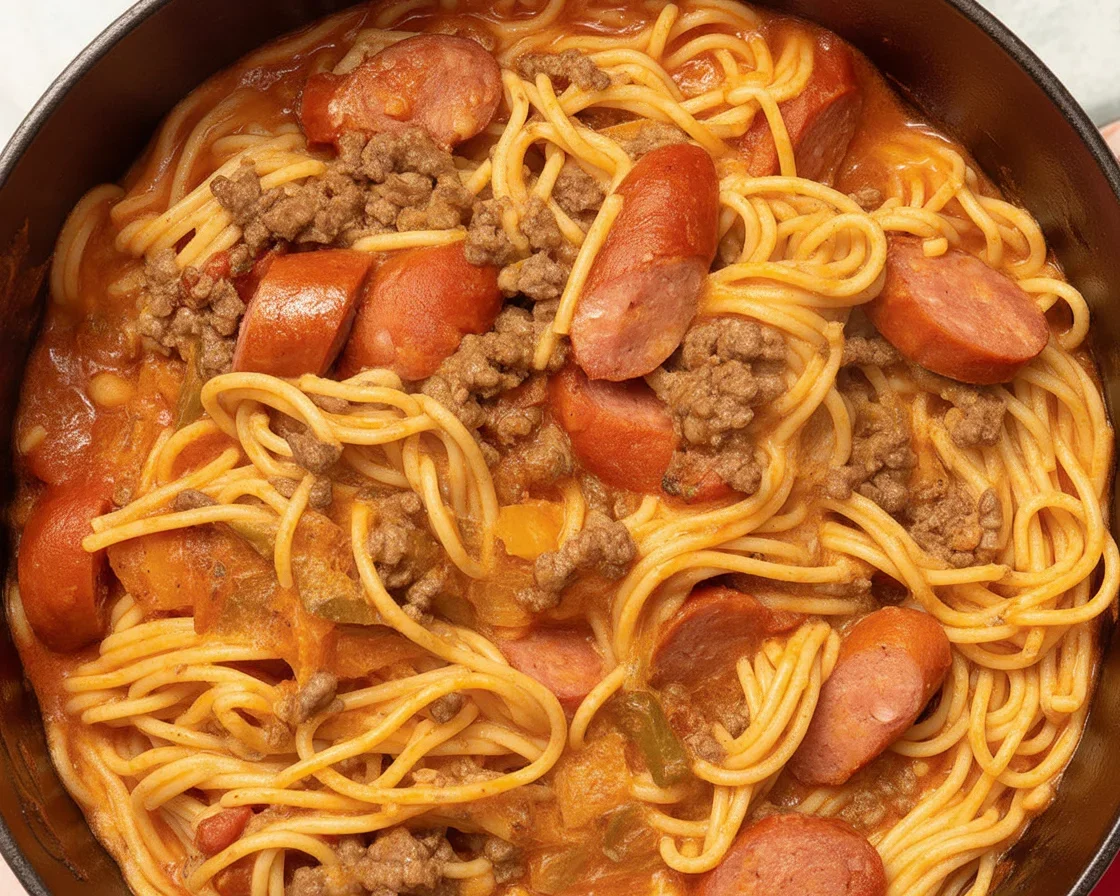Filipino spaghetti is that one party dish you crave when the mood strikes for something comforting, kinda quirky, and honestly way different from the Italian stuff. Maybe you’re just missing home, or your kids got that specific request (with plenty of hotdogs, obviously). If you’re clueless about how it’s made—or just want it to taste like a five-star Lola cooked it—this is your spot. I’ll break down what makes it so Filipino, how to get it on your table with minimum fuss, and even toss in a hack or two. But first, if you want to see even more ways to hit those sweet-salty cravings, check out this roundup of Filipino spaghetti for U.S. tastebuds and the sweet Filipino-style spaghetti recipe with hotdogs and cheese. You shouldn’t miss those for deeper dives. 
Whats In Filipino Spaghetti?
First off, the ingredients. Now, if you’re expecting classic Italian flavors, ha! This’ll flip your expectations. Filipino spaghetti starts with, of course, spaghetti noodles. Not the fancy stuff. Just the biggest bag from your local grocery store. Next, the sauce: this is where things take a left turn—tomato sauce, sure, but then we add banana ketchup. Yes, you heard right. Banana ketchup makes it sweet and tangy and just — wow. Brown sugar goes in, too. Sweetness? Cranked way up.
Now, on the meat side, ground pork or beef is usual, but honestly, hotdogs (the bright red ones!) are non-negotiable. Slice ’em thin so every bite has a pop of childhood. You want cheese, too—nothing delicate, just lots of grated cheddar. Not your usual Parmesan top. Some folks get fancy and toss in garlic or onion (I vote onion always). Butter or a splash of oil will help things blend and keep the sauce silky. Salt, pepper, sometimes a cheeky splash of soy sauce. That’s basically your shopping list.
I grew up sneaking extra hotdogs in when mom wasn’t looking. Wouldn’t you? Go with what feels right—Filipino spaghetti is super forgiving.
“This was the only spaghetti my picky eater would finish—she licked the plate. Thank goodness for banana ketchup!”

How To Make Filipino Spaghetti
Honestly? Making Filipino spaghetti is way simpler than it looks. There’s a rhythm, like dancing on a crowded fiesta.
First, boil your spaghetti noodles. Lots of water so they don’t glue themselves together. Salt the water—a lot. If you skip this, noodles can taste… bland. Trust me.
While that bubbles, grab a big pan (I always use the one with a mystery dent from college). Sauté onion and garlic in a bit of oil. Wait until they smell like home and are looking soft. Throw in your ground meat. Mash it around till it browns, no pink left. Season with salt, pepper, sometimes a bit of soy sauce if I feel extra.
Now for the kicker—banana ketchup, tomato sauce, and a scoop or three of brown sugar. Mix, mix, mix. Then dump in your sliced hotdogs. Let everything simmer together, not rushed. You want sweet, tangy, meaty magic.
When the sauce is thick enough to coat a spoon, pour it over your cooked noodles. Tumble everything together, or leave it separate (kids can be picky). Best part? Shower with grated cheese right before serving. More is better. Always.
“Your weird neighbor’s secret: he makes Filipino spaghetti for every birthday, and the whole block shows up. Coincidence? No way.”
Tips & Tricks
If you wanna really nail your Filipino spaghetti, remember these:
- Don’t overcook your noodles. Slightly firm is best—not mushy!
- Go heavy on banana ketchup if you like it extra sweet (it’s tradition, trust).
- Let the sauce simmer a bit longer for deeper flavor—patience pays off.
- Extra cheese melted on top right before serving? Indulgent, but perfect.
Boom. That’s all you really need.
Variations
Truth: there are a thousand ways to mess with the “original” Filipino spaghetti, and each family swears theirs is best. You can use ground chicken instead of pork if that’s what’s in the fridge (works, tastes lighter too).
Some toss in canned mushrooms or bell peppers for the veg vibes, especially at big celebrations. No cheddar? Any processed cheese will do. For the meat, sometimes even sausage slices sneaky-creep in.
Vegetarian versions? Yep, totally possible. Ditch the meat, double up the veggies, and swap for plant-based hotdogs (they exist, I promise). It’ll surprise you.
Kids sometimes refuse chunks, so you can blitz the sauce for smoothness. Or get wild—add pineapple tidbits for a Hawaiian spin. Anything goes, really.
“I grew up with spaghetti that was 75 percent hotdog and barely any sauce, and you know what? It was the best treat after a long school day.”
Why Filipinos Spaghetti is Sweet
People never believe me when I say Filipino spaghetti is sweet on purpose. Like, there’s a whole story behind it. See, banana ketchup was invented during World War II in the Philippines ‘cause tomatoes were scarce. Filipinos—always clever—used bananas and sugar instead. It stuck.
That “dessert gone savory” thing became the party standard. Sweetness gets cranked up for birthdays, holidays, rainy afternoons—basically, anytime the family needs cheering up. Plus, you feed spaghetti to kids and they finish their plates. Filipino spaghetti is comfort food in the happiest red sauce you can imagine.
Frankly, if you don’t use banana ketchup and a generous hand with sugar, you’re just making regular spaghetti—and that is never as fun. Try it and you’ll get what all the fuss is about.
“Filipino spaghetti gets polished off way before the fried chicken at every party. I refuse to believe otherwise.”

Common Questions
Q: Do I have to use banana ketchup?
A: Yep, if you want true Filipino spaghetti. But you can sub with regular ketchup plus extra sugar if desperate.
Q: How sweet should Filipino spaghetti be?
A: Sweet enough that your tastebuds notice, but not like dessert. Taste and adjust until it’s right for you.
Q: Can I make this in advance?
A: Totally! It’s even better leftover because the sauce soaks in overnight. Just keep noodles and sauce separate.
Q: What cheese do I use?
A: Regular cheddar is most common. Processed cheese is fine—anything that melts smooth and creamy.
Q: Is Filipino spaghetti spicy?
A: Rarely. But you can add hot sauce or chili flakes if you need a little kick.
There you go, the lowdown from my happy kitchen. If you want the real step-by-step guide with a few secrets my Lola somehow never wrote down, check this Filipino Spaghetti Recipe | The Kitchn. And hey, if you’re planning a family feast or want to try even more awesomely sweet Filipino picks for the kiddos, you’ll love digging through this collection on 10 kid-friendly Filipino recipes for U.S. families. Getting hungry yet? Go whip up some Filipino spaghetti—and tell me if your whole house doesn’t smell like a fiesta.
Filipino Spaghetti
Ingredients
Pasta and Sauce
- 1 lb spaghetti noodles Use the biggest bag from your local grocery store.
- 1 cup banana ketchup For that unique sweet and tangy flavor.
- 1 cup tomato sauce For the base of the sauce.
- 3 tbsp brown sugar Adjust according to taste for desired sweetness.
Meat and Dairy
- 1 lb ground pork or beef Use whichever is preferred.
- 6 links red hotdogs Slice thinly for even distribution in flavors.
- 2 cups grated cheddar cheese Preferably a processed cheese for melting.
Seasonings
- 1 tbsp salt For boiling pasta and seasoning meat.
- 1 tbsp pepper Adjust according to taste.
- 1 tbsp soy sauce Optional for added umami flavor.
- 1 tbsp oil For sautéing onions and garlic.
Vegetables
- 1 medium onion Finely chopped for sautéing.
- 2 cloves garlic Minced for additional flavor.
Instructions
Cooking the Pasta
- Boil water in a large pot, add plenty of salt, and then cook the spaghetti noodles according to package instructions until al dente.
Preparing the Sauce
- In a large pan, heat a bit of oil and sauté the chopped onion and minced garlic until soft and fragrant.
- Add in the ground meat, cooking until browned and no pink remains.
- Incorporate the banana ketchup, tomato sauce, and brown sugar to the pan. Mix well.
- Stir in the sliced hotdogs and allow the mixture to simmer until thickened.
Combining Everything
- Drain the cooked spaghetti and reduce the heat on the sauce.
- Pour the sauce over the noodles or mix them together, depending on preference.
- Top with generous amounts of grated cheese before serving.

